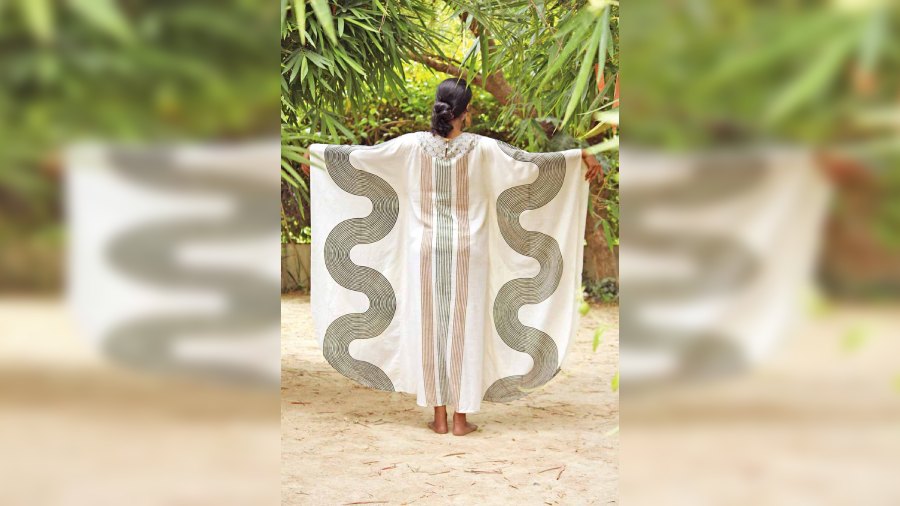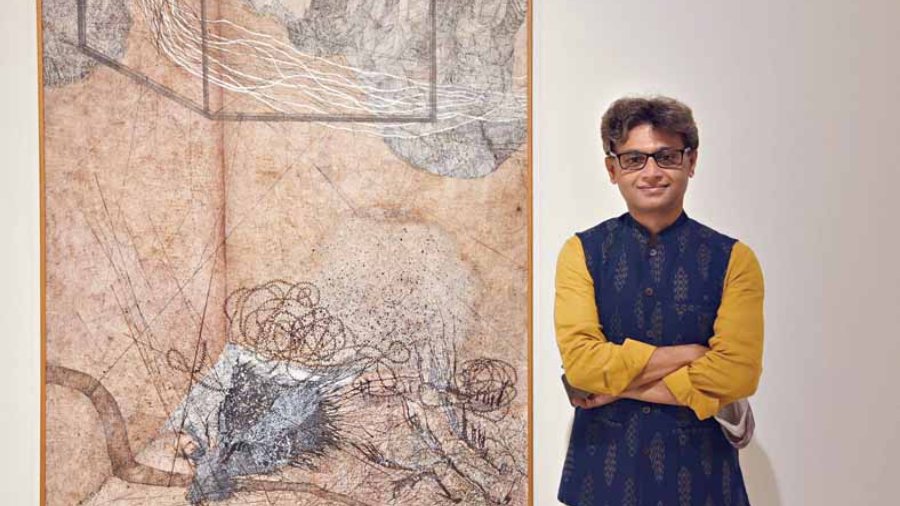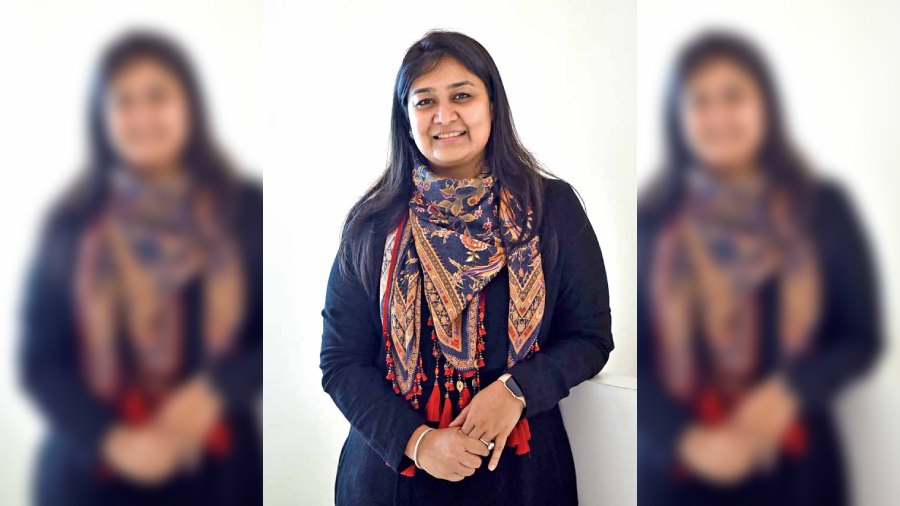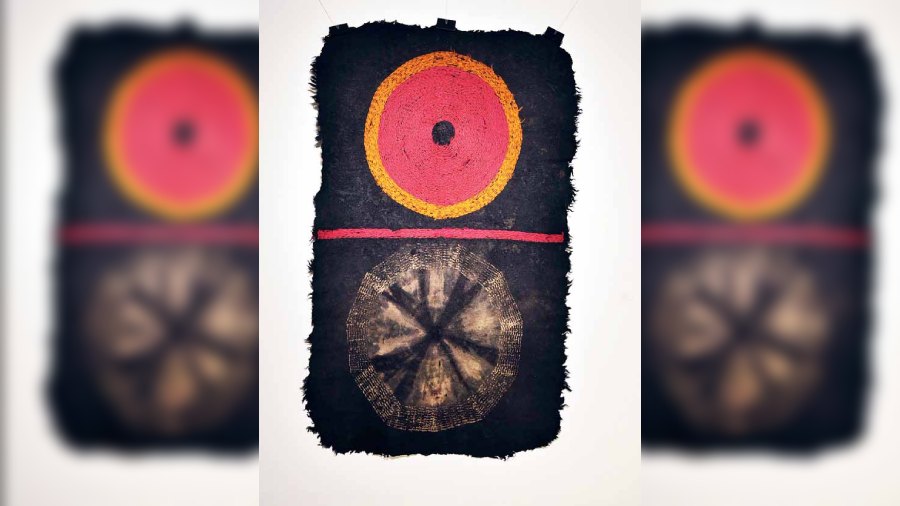Opening doors to three stellar exhibitions in tandem, Emami Art is hosting the works of 12 artists, including a unique series of cutouts by MF Husain and a retrospective of Riten Mozumdar’s works. With these exhibitions, the five-storey gallery space just herald in a multifaceted showcase for the city’s art lovers. It also reaffirmed the importance of collaboration in present times as this trifecta sees Emami Art work with five galleries from across the country.

Block print on cotton by designer Riten Mozumdar
The ground floor of the gallery leads you to The Politics of Paper that sees 10 contemporary artists engage with ‘paper’ in multiple ways — from medium and a means of practice to it being a mode of practice from a more philosophical purview. The fifth floor introduces people to Imprint: Riten Mozumdar that is a travelling exhibition being held in collaboration with Mumbai-based gallery, Chatterjee & Lal. The fourth floor is reserved for Essential Forms: An exhibition of M F Husain’s cut-outs on view for the first time from the Emami collection. The first two have been curated by Ushmita Sahu, while the third one is being presented by Ina Puri.

Adip Dutta
The Politics of Paper, featuring Adip Dutta, Anju Dodiya, Atul Dodiya, Chandra Bhattacharjee, Jagannath Panda, Jayashree Chakravarty, Mithu Sen, N.S. Harsha, Prasanta Sahu, T.V. Santosh, curated by Ushmita Sahu, on till March 30
Born from the idea of paper being an important paraphernalia of an artist’s life, along with the pandemic restoring its value of being an accessible medium, curator Sahu’s naming of this exhibition also looks at the paper’s political implications in contemporary India. “I was also reading a lot about the Santiniketan masters, most of whom were doing amazing work with paper. This idea of looking at artistic practices of contemporaries for whom paper has been important for a long time, started brewing in my mind,” said Sahu.
While Sen has always worked on paper, Atul Dodiya continued his works with paper alongside his larger (better known) body of works, almost as a “parallel practice”, according to Sahu. The fragile physicality of paper underscores the exhibition’s underlying cultural and socio-political aspects.

N.S. Harsha
Harsha’s installation that is central to the exhibition is made of waste paper packaging and became representative of the times and their practices, such as that of online shopping, waste and the filling of landfills. “I really like how different artists approach paper. Jayashreedi approaches paper as a material in which she embeds a lot of things while Harsha approaches paper as something that is present in our everyday lives. Prasanta’s installation of local vegetables that he has made out of tissue paper has names of different farmers he has spoken to as an act of politics and (encompasses) the fragility of the vocation of farming in our country right now. The element of politics underlying all the works is also different — sometimes it is very personal and sometimes, it is larger,” explained Sahu.
This ensemble exhibition sees Emami Art collaborate with multiple galleries to bring forth the works of the 10 artists that it showcases. Plans of engaging with students from art colleges and hosting workshops are also in the works.

Imprint: Riten Mozumdar by Emami Art, in Collaboration with Chatterjee & Lal and curated by Ushmita Sahu is on till April 8
This exhibition was born out of Sahu’s personal research into the Santiniketan-trained artist whose work span five decades across the realms of design and art, and is monumental in the landscape of modernist India’s design renaissance. “It was like peeling off layers and I was so intrigued. I was working independently then and so I worked with Chatterjee and Lal for their exhibition on Riten Mozumdar in 2019, after which it was supposed to come here but then the pandemic struck,” explained Sahu.
Mozumdar, who has been an integral part of India’s design history, had a deep practice in textile design that was also of an impressive width with notable experiences with Marimekko and Fabindia. His artistic practice of calligraphy on silk after returning to Santiniketan in the 80s is noteworthy as well. This exhibition has ensured that the works of Mozumdar have made its way back to his home turf for the first time since his passing in 2006.

Ina Puri in front of MF Husain’s Cut-outs
Essential Forms: An Exhibition of MF Husain’s Cut-outs is presented by Ina Puri. The exhibition is on till February 28
“Showing Husain is itself a challenge,” said Ina Puri about presenting this show of Husain’s cutouts.

A cutout by MF Husain
“Sometimes you learn about art from universities and at other times, you learn about art from the artist himself, which is what was my case with Husain,” added Puri. Born out of the act of making small cutouts for his children as toys, influenced by his days of working as an apprentice at a toy factory, Husain’s cutouts grew in scale and moved to a larger-than-life level. Made out of plywood, Husain drew outlines that were cut out and painted upon. Tangible in the physicality of their process of making, yet intangible in the fluidity of their abstract silhouettes, each cutout seems to be a figure caught in motion in Husain’s story.

Jayashree Chakravarty
“When I had visited the set of Gaja Gamini, I saw these huge bamboo groves he had made and I was left wondering how it would fit into the film. Later when I watched the film, I realised it was all planned out in his head — it was the perfect foil for a seductive Madhuri Dixit (Nene) and the dancers as they moved in the forest. In that context, see these cutouts as one work or see them as a story where these characters inhabit some strange world they are a part of — the choice is yours,” said Puri.

From Left: Tara Lal, Mortimer Chatterjee and Ushmita Sahu
And about showing this body of works in Kolkata, Puri said, “The whole joy of putting up this exhibition, apart from the fact that it is Husain saab’s works, is that it is in Kolkata. I have met a whole bunch of young artists, senior artists, art historians, lots of students and lots of strangers who have seen me on social media and are telling me that they will one day show their work here. That’s the magic of this city.”

It is very special for all of us to do these shows together. I am not going to say that it was very simple or easy — it was a very tall order. Collaboration is the way forward because independently, you can only grow so much but together, you can grow so much more. Tara (Lal) and Mort (Mortimer Chatterjee of Chatterjee & Lal in Mumbai) are here in complete support and they made sure that everything was ready in time for the Riten Mozumdar show. Them being here in person means a lot. I was very nervous about the Husain show because he is Husain saab, you don’t want to get it wrong! But Ina Puri curated it very well and all I needed to do was to provide back-end support. For The Politics of Paper, all the artists have been friends for a very long time but we spoke to all their respective galleries as well. Though this was supposed to happen last year, I am happy it has worked out well now — Richa Agarwal, CEO, Emami Art
Pictures: B. Halder & Emami Art






